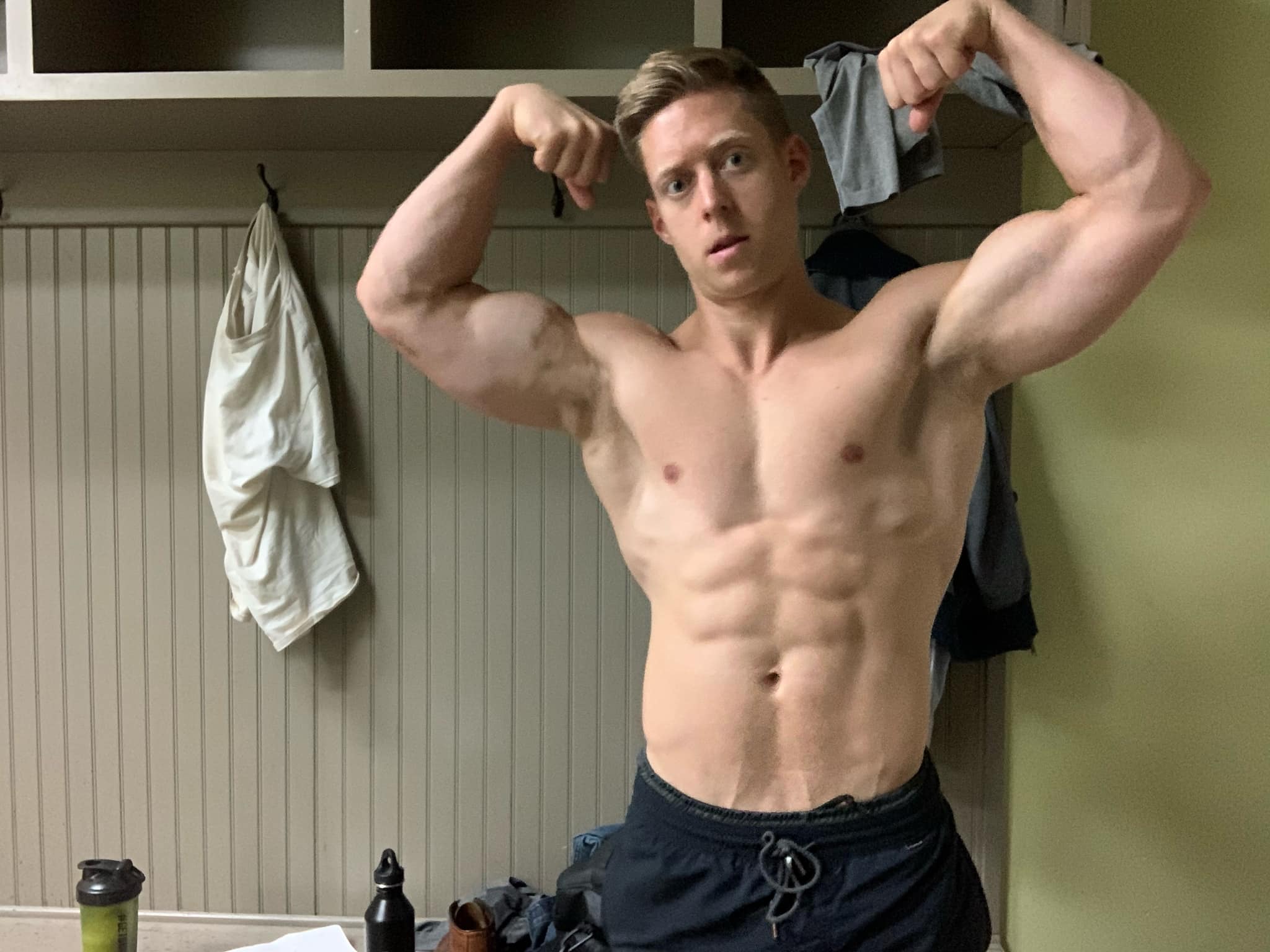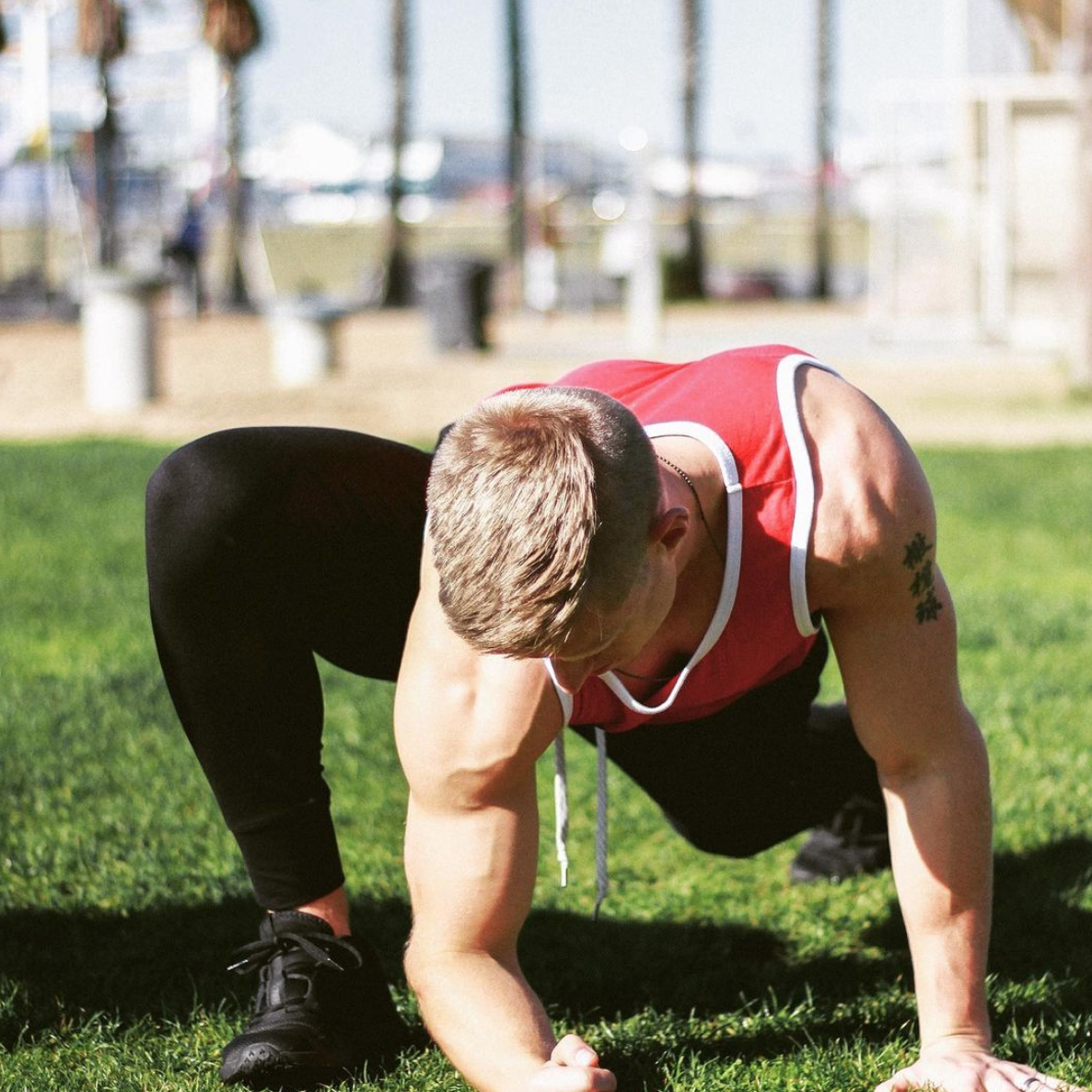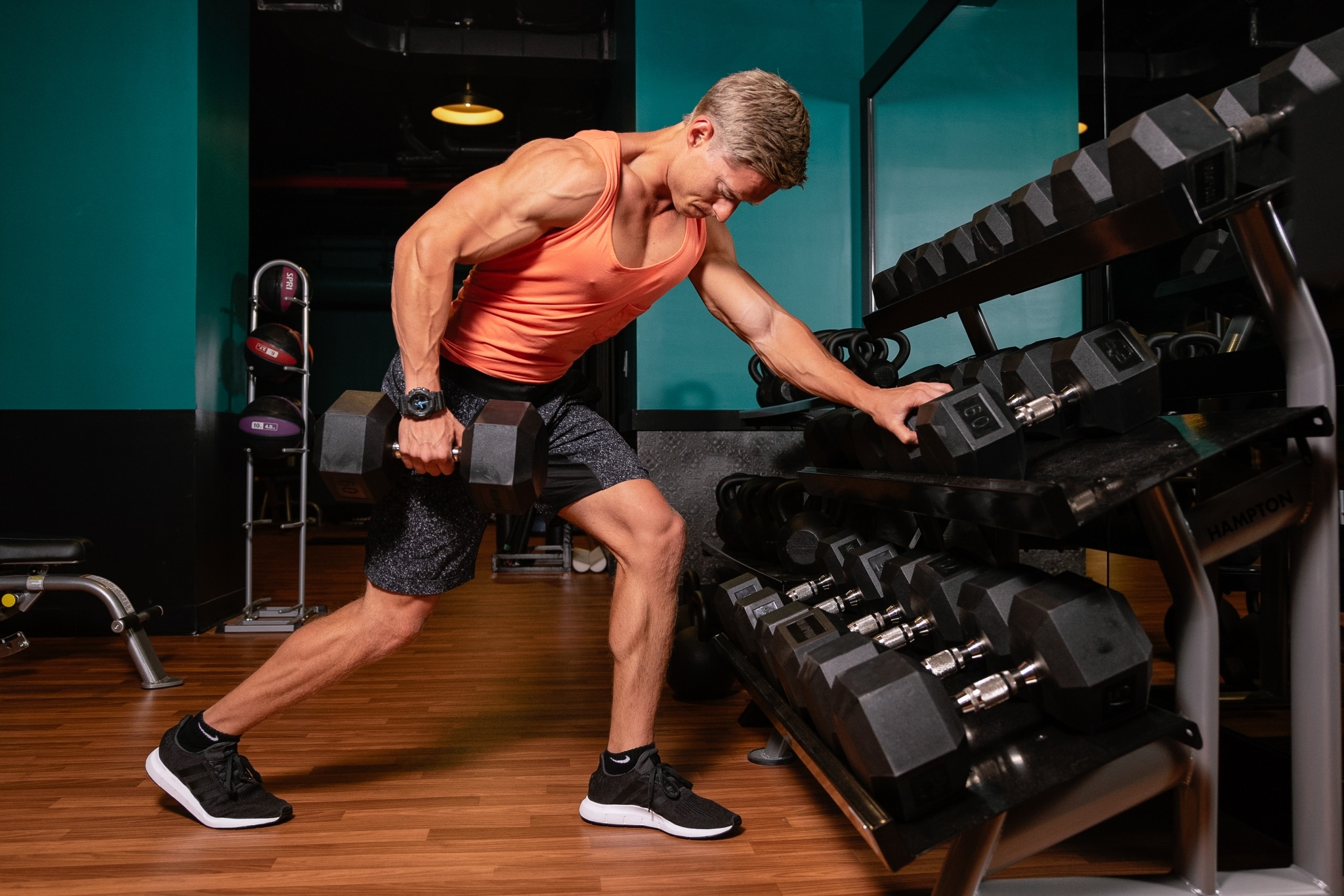How To Build Muscle After 30
August 2, 2021
Are you sick of spinning your wheels wondering how to build muscle after 30?
Building muscle after 30 is much harder than it is in your teens and 20’s.
Testosterone levels peak in your late teens and early 20’s.
After age 30, testosterone levels naturally decline about 1% per year.
While these declines can be prevented with strategic strength training, nutrition, and lifestyle habits, there’s a reason athletes over 30 are often said to have “lost a step” and people talk about “what they used to be.”
You’re less active than you were in your 20’s. Your “to-do list” and responsibilities grow immensely and with it, comes boatloads of stress and less sleep.
That said, at 32 with a family I have zero interest in giving into mother nature without a fight.
Over the next year, I’m committed to building lean muscle because I know it won’t be any easier from this point forward. And I want you to give you the inside scoop on what I’m doing to make it happen.
Your Guide To Building Muscle After 30
Below, I’m going to give you insight into my current training, what I’m doing, and more importantly, why I’m doing what I am.
Like the programs we design for our physique hacking clients, my training is unique to me; however, you’ll be able to swipe key principles and ideas to help you build muscle.

Build Muscle After 30: A Proven Training Split.
Your training split goes a long way in determining whether you’ll build lean muscle or not. For the majority of lifters, I recommend an upper-lower training split, such as the following:
As a caveat, there is no one size fits all training split. But, without question, an upper-lower split is my go-to split for the majority of my muscle-building clients.
UPPER-LOWER TRAINING SPLIT
Upper lower training splits alternate training your upper body and lower throughout the week. They’re ideal for training four days per week. A routine would look something like this:
Monday: Upper Body
Tuesday: Lower Body
Wednesday: Off
Thursday: Upper Body
Friday: Lower Body
Saturday/Sunday Off/cardio.
If your schedule only allows you to train three days per week you can split your week into an A-B schedule:
Week A:
Monday: Upper Body
Wednesday: Lower Body
Friday: Upper Body
Week B:
Monday: Lower Body
Wednesday: Upper Body
Friday: Lower Body
Pick whatever training frequency fits your schedule best. The most important factor in your training split is your ability to train consistently without missing days. Therefore, if your schedule is hectic you’re best airing on the side of caution. The primary reason most guys don’t build muscle after 30 isn’t a lack of training; rather, a lack of recovery.
PROS
Upper-lower training splits are a great split because they allow you ample recovery while training enough to build strength and muscle at the same time.
Compared to a typical body part split (chest Monday, Back Tuesday etc), upper-lower training splits allow you to hit muscles more frequently. For example, instead of hitting your chest one day per week (Monday), you can hit it twice during the week with an upper-lower split. Your volume needs to be lower during each workout, but increasing the frequency increases the number of times you boost muscle protein synthesis, potentially leading to more muscle growth.
Upper-lower splits allow you to train new exercises more often. Whether you’re learning a language. ora new exercise frequency is more important.
If you’re trying to learn how to speak mandarin, you’d be better off practicing for 30 minutes twice per week than once per week for an hour. The same principle applies to learning and improving exercise technique.
Once you pass 30 years old, optimal exercise technique becomes exponentially more important. You don’t have the recoverability you did in your 20’s. If you’ve been training hard, you have years of hard work on your joints.
Upper lower training splits will help you master exercise techniques to keep you healthier, leading to more consistent training and better muscle growth.
Build Muscle After 30: Workout Steps
Step One: Warm-Up
Performing a simple warm-up daily is the key to restoring mobility, wiping out pain and dysfunction, and making pain-free progress in the gym.
We spend most days hunched over our phones and laptops like Quasimodo examining his first Hustler magazine.
Hours, days, and weeks pass and shitty posture becomes your new natural.
Before you know it, your shoulders curve like a banana, your head pops forward like a turtle, and your once plump ass is flatter and less active than a flaccid…pancake.
Needless to say, this is a first-class ticket to injury if you don’t address it.
So, I perform a simple warm-up every day whether I train or not with my Every Day Warm-Up Protocol.
Step Two- Activators
If you don’t train explosively you lose it. Your athleticism will fall by the wayside and you’ll be left in the dust as a weekend warrior.
The busier (and older) you get the more important explosive training comes.
Prime your body before your main lift of the day with an explosive jump or throw. You’ll activate fast-twitch type-2 muscle fibers, rev up your central nervous system (CNS) and retain (or build) a glimmer of explosiveness to dominate life outside the gym.
Keep in mind, these exercises aren’t meant to leave you gasping for air before you lift. In the words of Lee Haney, “stimulate, don’t annihilate”–apply this wisdom to explosive exercises.
Doing explosive exercises before lifting Intermuscular coordination describes the coordination within different muscles and groups of muscles.
When selecting an explosive exercise mimic the strength training movement pattern for the day. Matching the explosive and strength lift for the day improves intermuscular coordination– the coordination within different muscles and groups of muscles.
Step Three- Strategic Strength System
The point of strength training is to build strength and muscle. After 30, you may not hit as many heavy lifts in your 30’s, but going relatively heavy is still crucial.
You should emphasize multi-joint, compound lifts like squats, deadlifts, lunges, bench presses, and the like. These will activate the most amount of muscle and trigger the greatest release of testosterone/growth hormone to support muscle growth.
According to a study by Fry et al in 2004, maximum growth occurs with loads between 80-95% of your 1-rep max (1RM) when sufficient volume is present. This equates to sets of 2-8 reps, depending on the lifter. If you’re over 30, I’d air towards 5-8 reps on the majority of exercises.
If you’ve built decent levels of strength, lifting exclusively with loads over 80% of 1RM ultimately leads to problems.
Your joints and nervous system will crack before your mind gives up or your ego tells you to pull back.
Once you’ve built a base of strength, you eventually adopt a two-fold approach:
- You maximize muscle fiber recruitment to get the most out of training.
- You train with enough volume to create progressive overload and to build more muscle.
Once you build your strength base, improved motor unit recruitment and work capacity allow you to stimulate more muscle fibers and handle relatively heavier training loads. You’ll be able to achieve greater levels of metabolic stress, mechanical tension, and muscular damage, which are the three primary methods of muscular hypertrophy.
Therefore, you can’t simply rely on heavy lifting to maximize muscle gains.
Instead, you need a mix of high training loads to build work capacity and improve muscle unit recruitment, while mixing in lighter loads to increase the total workload.
Movement Patterns and Exercise Selection:
Focus on the big rocks of strength training: selecting compound exercises.
Squat Pattern: Squat, front squat, box squat, goblet squat, Heels elevated trap bar deadlift
Hinge Pattern: Conventional, Sumo, RDL, or Trap bar deadlift
Horizontal Pull: Dumbbell row, landmine row, barbell row, pendlay row
Horizontal Push: Dumbbell or barbell incline, decline, or flat bench.
We recommend performing an ascending loading scheme where you perform 1-2 warm-up sets, After the warm-up sets, increase the weight on each work set finishing with the last set being your heaviest.
Step Four-Metabolic Muscle Builders
Step four is designed to maximize metabolic stress and muscular damage to promote muscle growth.
While your main compound exercise described above is done with performance in mind, your pump exercises should be done with a focus on maximizing the quality of your muscular contraction and never chasing weight at the expense of joint position or rep quality.
Classic muscle-building sets and rep schemes like 3×8, 3×10, and 4×12 can all be found in step three.
On each exercise use a 3-1-1-0 tempo. Using a bench press as an example here’s what this means:
3 – Take 3 seconds to lower the barbell to your chest (eccentric phase)
0 – Do not pause with the weight resting on your chest (first pause phase)
1 – Raise the weight at speed using one second to return the barbell to the starting position (concentric phase)
0 – Do not rest before starting the next repetition (second pause phase)
Volume work will follow the pattern of the day, supporting the main strength lift.
To combat muscular imbalances from everyday life and poor programming we see in 90% of lifters we’ll be posterior chain dominant.
Areas like the glutes, hamstrings, rear delts, and upper back will get significant time under tension creating the ideal scenario for growth and support for the heavy strength movements.
What about cardio?
Once per week, I’ll do some form of high-intensity intervals, a strength circuit, sled pushes, or sprints for about 20 minutes. I’ll go all out for 10 seconds, rest for 50 (or longer), then go all out again.
Daily Walks: I get at least 10k steps per day, with a chunk coming from a 30-40 minute walk in the morning with my dog. This is crucial for heart and mental health.
Sleep:
With a one-year-old at home, the importance of quality sleep has never been more obvious. Most days, I go to bed around 10:00 am and wake up around 6:00 Pm.
Sleep improves every aspect of health and performance imaginable from mood and memory to optimizing testosterone levels and insulin sensitivity. I’d prefer not to beat a dead horse, but you need to sleep. And if you need more strategies to optimize your sleep, you need this article: 9 Ways To Boost Sleep Quality

Illustration depicting a roadsign with ‘the big picture’ concept. Sky background.
Muscle Building Workout
Here’s a sample workout tying in all the components covered above.
Monday – Lower Body
A1. Broad Jump 3 x 5
A2. Trap Bar Deadlift 5 x 3-6
C1. Barbell RDL (3-4s eccentric) 4 x 6-8
C2 90/90 Hip Stretch 3 x 3/5sec holds each side
D1. Dumbbell One-Arm Row x50 total reps with 90 lb Kettlebell.
D2. Ab Wheel Rollout x50 total reps in as few sets as possible
Tuesday Upper Body
A1. Plyo Bench Pushup 3 x 5-6
A2. 15 Degree Barbell Bench Press 5 x 3-6
B1. Single Arm Incline Dumbbell Press 3 x 10ea
C1. Ring Dip 3x 10ea
C2. Ring Inverted Row 3×10
D1. DB Lean Away Lateral Raise 3×12,10,8
D2. Dumbbell Lateral Raise 3×15,12,10
Thursday – Lower Body
A1. Box Jumps 3×5
B1. Front Squat 5 x 3-6
C1. Bulgarian Split Squat 5 x 10ea, 3sec hold at the bottom of each rep
C2. Single-Leg Stability Ball Leg Curl 3 x 10
D1. Cable Crunch 3 x 12
D2. Hanging Leg Raise 3 x 10ea
D3. Calf Raise 3 x 8-10 (1-3-5 tempo, hold at the top for 3s then take 5s to lower)
Saturday: Upper
A1. Med Ball Overhead Slam 3 x 5
A2. Pull-ups 5 x 3-8, Use a weighted vest or belt attachment if necessary
C1. Chest supported Row 4 x 9-11
C2. Incline Bicep Curls 4 x 9-11
D1. Cable Triceps Pushdown 3×10-15
D2. Cable Triceps Overhead Extension 3×10-15
D3. Ring Push Up 3xFailure
Workout Notes:
When you pick a pillar strength movement stick with it for the entire rotation.
Run this for 4 weeks, adding no more than 5-10% to your strength lift every week. Back off to the original load for a “deload” on the 5th week, then ramp it back up again.
If you don’t have all the pre-requisite equipment listed make do with what you have. Match movement patterns to the equipment at your disposal, like using a dumbbell incline bench press if you don’t have a barbell.
Your prescribed sets are 3-4 rounds, but you could certainly do fewer. Make sure to do enough ramp-up sets before starting your actual work sets.
Can You Still Build Muscle After 30?

In short, yes. It’s not going to be as easy as it was in your 20’s, but that’s okay. When your goal is building muscle all forces must be aligned in that direction.
You must set your expectations in reality. This article will help you gauge what’s practical.
Follow a muscle-building diet and eating a calorie surplus daily, not just on the days you train.
Actively work to reduce stress and sleep better, even if you’re busy. Proper sleep beats any supplement or nootropic for brain function by a mile.
Finally, you must commit to the process. Contrary to popular media, you can lose fat quickly. By comparison, building muscle takes much longer. The majority of lifters throw in the towel too fast or quit because they gain some body fat.
Make no mistake, this is a first-class ticket to spinning your wheels and having a mediocre physique.
So if you’re looking for a proven method to maximize lean muscle growth without living in the gym…









[…] Because of the (good) metabolic and muscular damage that’ll result from these supersets, you will need longer rest periods during the workout and longer recovery periods between training sessions for the same muscle group. […]